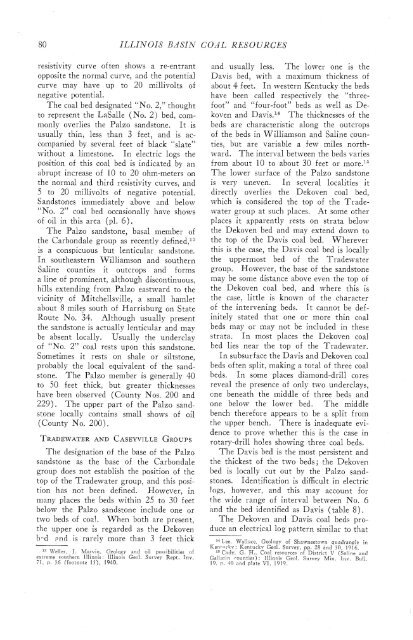subsurface geology and coal resources of the pennsylvanian system ...
subsurface geology and coal resources of the pennsylvanian system ...
subsurface geology and coal resources of the pennsylvanian system ...
Create successful ePaper yourself
Turn your PDF publications into a flip-book with our unique Google optimized e-Paper software.
80 ILLINOIS EASIN COAL RESOURCES<br />
resistivity curve <strong>of</strong>ten shows a re-entrant<br />
opposite <strong>the</strong> normal curve, <strong>and</strong> <strong>the</strong> potential<br />
curve may have up to 20 millivolts <strong>of</strong><br />
negative potential.<br />
The <strong>coal</strong> bed designated "No. 2," thought<br />
to represent <strong>the</strong> LaSalle (No. 2) bed, commonly<br />
overlies <strong>the</strong> Palzo s<strong>and</strong>stone. It is<br />
usually thin, less than 3 feet, <strong>and</strong> is accompanied<br />
by several feet <strong>of</strong> black "slate"<br />
without a limestone. In electric logs <strong>the</strong><br />
position <strong>of</strong> this <strong>coal</strong> bed is indicated by an<br />
abrupt increase <strong>of</strong> 10 to 20 ohm-meters on<br />
<strong>the</strong> normal <strong>and</strong> third resistivity curves, <strong>and</strong><br />
5 to 20 millivolts <strong>of</strong> negative potential.<br />
S<strong>and</strong>stones immediately above <strong>and</strong> below<br />
'(No. 2" <strong>coal</strong> bed occasionally have shows<br />
<strong>of</strong> oil in this area (pl. 6).<br />
The Palzo s<strong>and</strong>stone, basal member <strong>of</strong><br />
<strong>the</strong> Carbondale group as recently defined,''<br />
is a conspicuous but lenticular s<strong>and</strong>stone.<br />
In sou<strong>the</strong>astern Williamson <strong>and</strong> sou<strong>the</strong>rn<br />
Saline counties it outcrops <strong>and</strong> forms<br />
a line <strong>of</strong> prominent, although discontinuous,<br />
hills extending from Palzo eastward to <strong>the</strong><br />
vicinity <strong>of</strong> Mitchellsville, a small hamlet<br />
about 8 miles south <strong>of</strong> Harrisburg on State<br />
Route No. 34. Although usually present<br />
<strong>the</strong> s<strong>and</strong>stone is actually lenticular <strong>and</strong> may<br />
be absent locally. Usually <strong>the</strong> underclay<br />
<strong>of</strong> "No. 2" <strong>coal</strong> rests upon this s<strong>and</strong>stone.<br />
Sometimes it rests on shale or siltstone,<br />
probably <strong>the</strong> local equivalent <strong>of</strong> <strong>the</strong> s<strong>and</strong>stone.<br />
The Palzo member is generally 40<br />
to 50 feet rhick, but greater thicknesses<br />
have been observed (County Nos. 200 <strong>and</strong><br />
229). The upper part <strong>of</strong> <strong>the</strong> Palzo s<strong>and</strong>stone<br />
locally contains small shows <strong>of</strong> oil<br />
(County No. 200).<br />
The designation <strong>of</strong> <strong>the</strong> base <strong>of</strong> <strong>the</strong> Palzo<br />
s<strong>and</strong>stone as <strong>the</strong> base <strong>of</strong> <strong>the</strong> Carbondale<br />
group does not establish <strong>the</strong> position <strong>of</strong> <strong>the</strong><br />
top <strong>of</strong> <strong>the</strong> Tradewater group, <strong>and</strong> this position<br />
has not been defined. However, in<br />
many places <strong>the</strong> beds within 25 to 30 feet<br />
be lo^ <strong>the</strong> Palm s<strong>and</strong>stone include one or<br />
two beds <strong>of</strong> <strong>coal</strong>. When both are present,<br />
<strong>the</strong> upper one is regarded as <strong>the</strong> Dekoven<br />
b-d 2nd is rarely more than 3 feet thick<br />
lVVellcr, 1. Marvin, Geology <strong>and</strong> oil posqibilities <strong>of</strong><br />
extreme eou<strong>the</strong>rn Illinois: Illinois Geol. Sulvey Rept. Inv.<br />
51, p. 36 (footnote 13). 1940.<br />
<strong>and</strong> usually less. The lower one is <strong>the</strong><br />
Davis bed, with a maximum thickness <strong>of</strong><br />
about 4 feet. In western Kentucky <strong>the</strong> beds<br />
have been called respectively <strong>the</strong> "threefoot"<br />
<strong>and</strong> "four-foot" beds as well as Dekoven<br />
<strong>and</strong> Davis.14 The thicknesses <strong>of</strong> <strong>the</strong><br />
beds are characteristic along <strong>the</strong> outcrops<br />
<strong>of</strong> <strong>the</strong> beds in Williamson <strong>and</strong> Saline counties,<br />
but are variable a few miles northward.<br />
The interval between <strong>the</strong> beds varies<br />
from about 10 to about 30 feet or more."<br />
The lower surface <strong>of</strong> <strong>the</strong> Palzo s<strong>and</strong>stone<br />
is very uneven. In several localities it<br />
directly overlies <strong>the</strong> Dekoven <strong>coal</strong> bed,<br />
which is considered <strong>the</strong> top <strong>of</strong> <strong>the</strong> Tradewater<br />
group at such places. At some o<strong>the</strong>r<br />
places it apparently rests on strata below<br />
<strong>the</strong> Dekoven bed <strong>and</strong> may extend down to<br />
<strong>the</strong> top <strong>of</strong> <strong>the</strong> Davis <strong>coal</strong> bed. Wherever<br />
this is <strong>the</strong> case, <strong>the</strong> Davis <strong>coal</strong> bed is locally<br />
<strong>the</strong> uppermost bed <strong>of</strong> <strong>the</strong> Tradewater<br />
group. However, <strong>the</strong> base <strong>of</strong> <strong>the</strong> s<strong>and</strong>stone<br />
may be some distance above even <strong>the</strong> top <strong>of</strong><br />
<strong>the</strong> Dekoven <strong>coal</strong> bed, <strong>and</strong> where this is<br />
<strong>the</strong> case, little is known <strong>of</strong> <strong>the</strong> character<br />
<strong>of</strong> <strong>the</strong> intervening beds. It cannot be definitely<br />
stated that one or more thin <strong>coal</strong><br />
beds may or may not be included in <strong>the</strong>se<br />
strata. In most places <strong>the</strong> Dekoven <strong>coal</strong><br />
bed lies near <strong>the</strong> top <strong>of</strong> <strong>the</strong> Tradewater.<br />
In <strong>subsurface</strong> <strong>the</strong> Davis <strong>and</strong> Dekoven <strong>coal</strong><br />
beds <strong>of</strong>ten split, making a total <strong>of</strong> three <strong>coal</strong><br />
beds. In some places diamond-drill cores<br />
reveal <strong>the</strong> presence <strong>of</strong> only two underclays,<br />
one beneath <strong>the</strong> middle <strong>of</strong> three beds <strong>and</strong><br />
one below <strong>the</strong> lower bed. The middle<br />
bench <strong>the</strong>refore appears to be a split from<br />
<strong>the</strong> upper bench. There is inadequate evidence<br />
to prove whe<strong>the</strong>r this is <strong>the</strong> case in<br />
I-otasy-drill holes showing three <strong>coal</strong> beds.<br />
The Davis bed is <strong>the</strong> most persistent <strong>and</strong><br />
<strong>the</strong> thickest <strong>of</strong> <strong>the</strong> two beds; <strong>the</strong> Dekoven<br />
bed is locally cut out by <strong>the</strong> Palzo s<strong>and</strong>stones.<br />
Identification is difficult in electric<br />
logs, however, <strong>and</strong> this may account for<br />
<strong>the</strong> wide range <strong>of</strong> interval between No. 6<br />
md <strong>the</strong> bed identified as Davis (table 8).<br />
The Dekoven <strong>and</strong> Davis <strong>coal</strong> beds produce<br />
an electrical log pattern similar to that<br />
'"Lee, Wallace. Geology <strong>of</strong> Shawneetown quadransle in<br />
1ieni~irk1-: TCentuckv Geol. Survey, pp. 28 <strong>and</strong> 30. 1916.<br />
1T~ndy. G. H.. Coal <strong>resources</strong> <strong>of</strong> District 57 (Saline <strong>and</strong><br />
Gallatin counties): Illinois Geol. Survey Min. Tnv. Bull.<br />
19. p. 10 <strong>and</strong> plate VI, 1919.
















